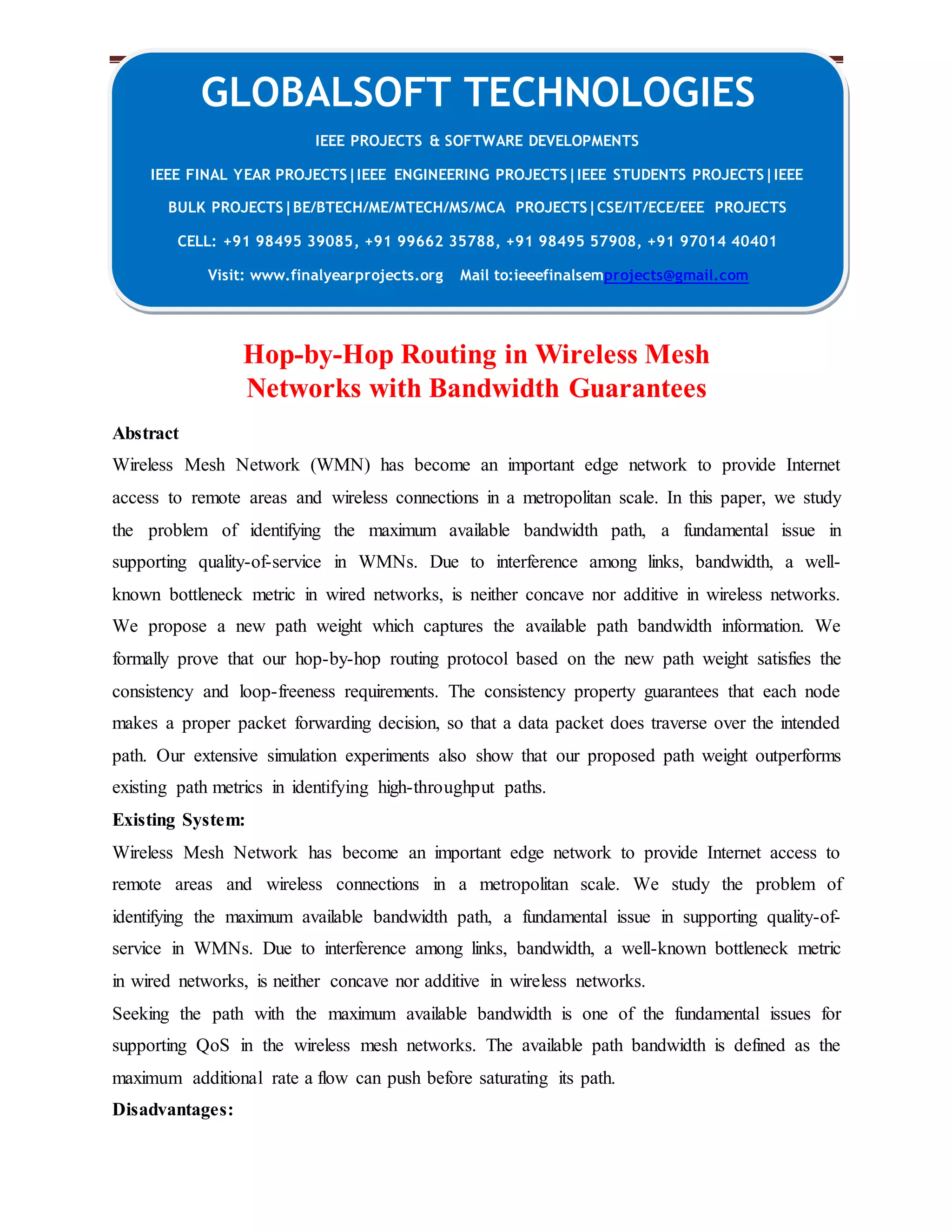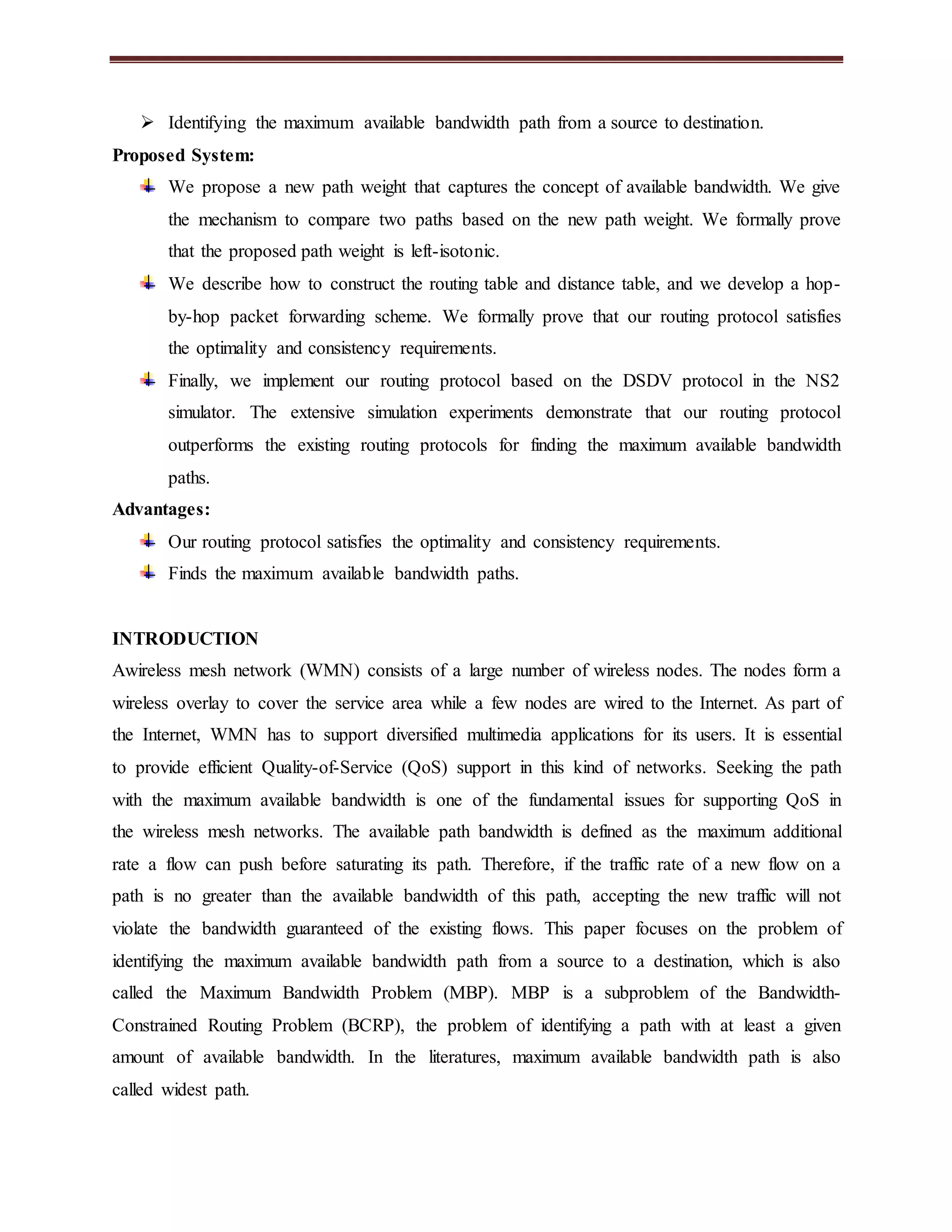This document discusses the development of a hop-by-hop routing protocol for wireless mesh networks (WMNs) that addresses the maximum available bandwidth path problem, crucial for quality-of-service support. A new path weight metric is introduced, which ensures optimal and consistent routing decisions, outperforming existing methods in identifying high-throughput paths. Extensive simulations validate the protocol's efficiency in providing guaranteed bandwidth through a proactive approach to network routing.




![the routing field in a packet. Therefore, our mechanism possesses the same characteristics of a
hop-by-hop packet routing mechanism, and is a distributed packet forwarding scheme.
Route Update
After the network accepts a new flow or releases an existing connection, the local available
bandwidth of each node will change, and thus the widest path from a source to a destination may
be different. When the change of the local available bandwidth of a node is larger than a
threshold (say 10 percent), the node will advertise the new information to its neighbors. After
receiving the new bandwidth information, the available bandwidth of a path to a destination may
be changed. Although the node is static, the network state information changes very often.
Therefore, our routing protocol applies the route update mechanism in DSDV . Based on DSDV,
each routing entry is tagged with a sequence number which is originated by the destination, so
that nodes can quickly distinguish stale routes from the new ones. Each node periodically
transmits updates and transmits updates immediately when significant new route information is
available. Given two route entries from a source to a destination, the source always selects the
one the larger sequence number, which is newer, to be kept in the routing table. Only if two
entries have the same sequence number, our path comparison is used to determine which path
should be kept. Due to the delay of the route update propagation, it is possible that route
information kept in some nodes is inconsistent. For instance, the widest path kept in the routing
table may not be the widest anymore. Routing loops may occur as well. The situations are
referred as inconsistency due to transient route updates, which is different from the definition
used in. In and this paper, we consider whether packets can be routed on the computed widest
path when the routing tables are stable. How to avoid loops when routing tables change is an
important but difficult problem, and is outside the scope of this paper. We refer readers to [29]
for the techniques to reduce route update inconsistencies in the distance-vector protocol which
can be applied in our mechanism as well.
System Requirements:
SOFTWARE Requirements](https://image.slidesharecdn.com/hop-by-hoproutinginwirelessmeshnetworkswithbandwidthguarantees-141005003030-conversion-gate02/75/2014-IEEE-JAVA-NETWORKING-PROJECT-Hop-by-hop-routing-in-wireless-mesh-networks-with-bandwidth-guarantees-5-2048.jpg)
![ PLATFORM : JDK 1.5
TOOL : Java Swing
DATABASES : SQL Server
HARDARE Requirements
PROCESSOR : PENTIUM IV 2.6 GHz
RAM : 512 MB DD RAM
MONITOR : 15” COLOR
HARD DISK : 40 GB
KEYBOARD : STANDARD 102 KEYS
MOUSE : 3 BUTTON
REFERENCES
[1] Q. Zhang and Y.-Q. Zhang, “Cross-Layer Design for QoS Support in Multihop Wireless
Networks,” Proc. IEEE, vol. 96, no. 1, pp. 234-244, Jan. 2008.
[2] T. Salonidis, M. Garetto, A. Saha, and E. Knightly, “Identifying High Throughput Paths in
802.11 Mesh Networks: A Model-Based Approach,” Proc. IEEE Int’l Conf. Network Protocols
(ICNP ’07), pp. 21-30, Oct. 2007.
[3] C.-Y. Chiu, Y.-L. Kuo, E. Wu, and G.-H. Chen, “Bandwidth- Constrained Routing Problem
in Wireless Ad Hoc Networks,” IEEE Trans. Parallel and Distributed Systems, vol. 19, no. 1, pp.
4-14, Jan. 2008.
[4] J. Tang, G. Xue, and W. Zhang, “Interference-Aware Topology Control and QoS Routing in
Multi-Channel Wireless Mesh Networks,” Proc. ACM MobiHoc, pp. 68-77, May 2005.
[5] Y. Yang and R. Kravets, “Contention-Aware Admission Control for Ad Hoc Networks,”
IEEE Trans. Mobile Computing, vol. 4, no. 4, pp. 363-377, Apr. 2009.
[6] H. Li, Y. Cheng, C. Zhou, and W. Zhuang, “Minimizing End-to- End Delay: A Novel
Routing Metric for Multi-Radio Wireless Mesh Networks,” Proc. IEEE INFOCOM, pp. 46-53,
Apr. 2009.](https://image.slidesharecdn.com/hop-by-hoproutinginwirelessmeshnetworkswithbandwidthguarantees-141005003030-conversion-gate02/75/2014-IEEE-JAVA-NETWORKING-PROJECT-Hop-by-hop-routing-in-wireless-mesh-networks-with-bandwidth-guarantees-6-2048.jpg)
![[7] Y. Yang and J. Wang, “Design Guidelines for Routing Metrics in Multihop Wireless
Networks,” Proc. IEEE INFOCOM, pp. 2288- 2296, Apr. 2008.
[29] C.E. Perkins and P. Bhagwat, “Highly Dynamic Destination- Sequenced Distance-Vector
Routing (DSDV) for Mobile Computers,” Proc. ACM SIGCOMM, pp. 234-244, Aug. 1994.
CONCLUSION
In this paper, we studied the maximum available bandwidth path problem, which is a
fundamental issue to support quality-of-service in wireless mesh networks. The main
contribution of our work is a new left-isotonic path weight which captures the available path
bandwidth information. The left-isotonicity property of our proposed path weight facilitates us to
develop a proactive hop-by-hop routing protocol, and we formally proved that our protocol
satisfies the optimality and consistency requirements. Based on the available path bandwidth
information, a source can immediately determine some infeasible connection requests with the
high bandwidth requirement. We tested the performance of our protocol under different
scenarios.](https://image.slidesharecdn.com/hop-by-hoproutinginwirelessmeshnetworkswithbandwidthguarantees-141005003030-conversion-gate02/75/2014-IEEE-JAVA-NETWORKING-PROJECT-Hop-by-hop-routing-in-wireless-mesh-networks-with-bandwidth-guarantees-7-2048.jpg)